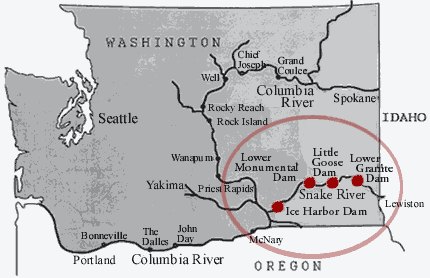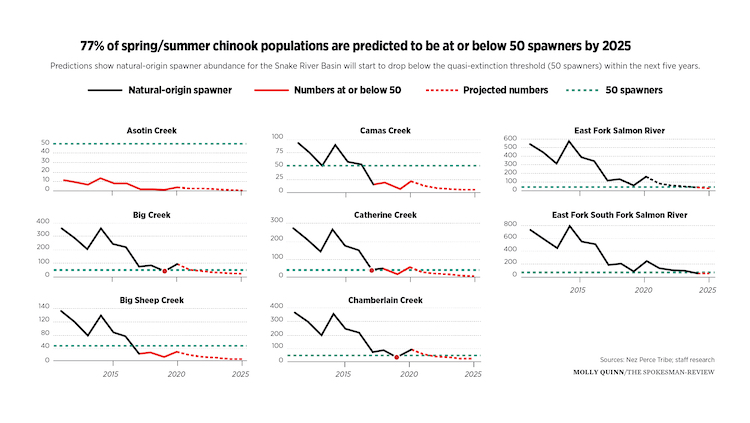forum
library
tutorial
contact

To Save Salmon,
Snake River Dams Must Be Removed
by Lacey Deweert
The Columbian, June 27, 2022
|
the film forum library tutorial contact |

|
To Save Salmon,
by Lacey Deweert
|
While many factors have contributed to push this iconic species toward extinction,
the largest obstacle blocking salmon recovery is the four Lower Snake River dams.
 I cannot imagine a life without salmon swimming freely in the rivers of the Northwest. Fishing has been a part of my identity and lifestyle since I was a child.
I cannot imagine a life without salmon swimming freely in the rivers of the Northwest. Fishing has been a part of my identity and lifestyle since I was a child.
I grew up fishing for trout with my family in Kelso, and the heritage of fishing in the Northwest is something I love to share with other anglers. Fishing is a passion that my husband and I both share, and for the past 21 years we have owned and operated Total Fisherman Guide Service out of Astoria, Ore.
I am a professional fishing guide and teacher based in Woodland, which rests on the shores of the Lewis and Columbia rivers. To this day, I fish nine months of the year. It would be an understatement to say the recovery of salmon is important to my family, livelihood, and the future of our fishing heritage.
For the last 50 years we have had a front-row seat to witness the decline of wild Northwest salmon. While many factors have contributed to push this iconic species toward extinction, the largest obstacle blocking salmon recovery is the four Lower Snake River dams. These dams lower the number of salmon returning to spawn and hinder smolt as they journey to the sea.
Salmon have defined our Northwest communities for generations and our economic well-being is directly tied to the survival of these iconic fish. In Washington, over 940,000 people fish, spending $1.5 billion and supporting 15,000 jobs.
For centuries, harvesting salmon on the Columbia and Snake rivers has been crucial to Northwest tribal communities. They rely on salmon to sustain their culture and identity.
Removing the dams would ensure our nation honors the treaties with Northwest tribes by ensuring they have access to the salmon with a true plan for restoration. A study from the Nez Perce Tribe documents that given current trends, nearly 80 percent of wild spring chinook populations in the Snake River Basin will be nearing extinction by 2025.
 We have also seen a colossal waste of taxpayer dollars -- to the tune of $17 billion -- spent over the years on half-measures for salmon recovery that have come up short as the species continues to decline. Now is the time to forge forward and invest in real solutions before we preside over the extinction of Northwest salmon.
We have also seen a colossal waste of taxpayer dollars -- to the tune of $17 billion -- spent over the years on half-measures for salmon recovery that have come up short as the species continues to decline. Now is the time to forge forward and invest in real solutions before we preside over the extinction of Northwest salmon.
The move toward a true salmon recovery is gaining momentum.
A year ago, Rep. Mike Simpson, R-Idaho, truly got the conversation started. He engaged communities from the region through stakeholder meetings and came up with a plan that would recover salmon, invest in Northwest communities and restore the lower Snake River by removing the four dams. The plan was also unanimously supported by the Affiliated Tribes of Northwest Indians, comprised of 57 tribes across the region, and they recently reiterated their support.
Washington Gov. Jay Inslee and Sen. Patty Murray have kept the conversation going in earnest and have promised to release their own plan to recover salmon by the end of July this year. They have released a draft plan and Washingtonians will have a chance to add their voices supporting a true recovery plan for salmon by ensuring any plan that moves forward calls for the removal of the four lower Snake River dams.
We have more momentum than we have ever had on the effort to recover salmon and we need to seize this opportunity to invest in healthy, free-flowing rivers that would benefit recreation and tourism as well as honoring our commitments to Northwest tribes.
This is our moment and I hope you will join me in calling on our leaders to support removing the lower Snake River dams and move forward with a true plan to recover salmon and invest in our Northwest communities.
learn more on topics covered in the film
see the video
read the script
learn the songs
discussion forum